Risk Management and Trade Criteria - Crypto Academy / S5W7- Homework Post for @reminiscence01
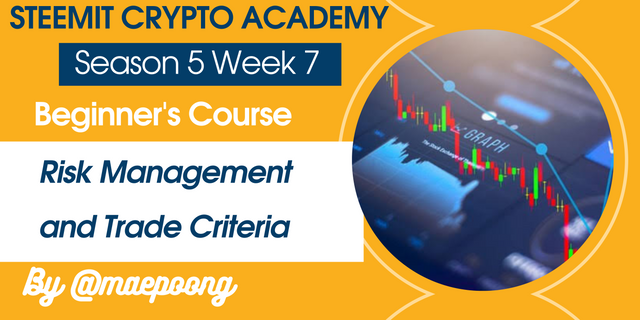

1. What do you understand by "Risk Management"? What is the importance of risk management in Crypto Trading?.

We can get a series of successful transactions. We may also face a series of bad deals that depend on luck and feelings.
Successful and experienced professional traders can even lose 10 trades in a row. Without risk management, this can result in the loss of our funds and eventually being wiped out. The most important goal in trading is to stay in the market and keep our funds. As long as we are in the market, we can make up for our losses.
Overall, risk management defines how to deal with risk, not just how to mitigate it. There must also be strategic thinking to reduce unavoidable risks in the most effective way.
In a financial transaction scenario, there are many reasons for the risk of a strategy or transaction arrangement. For example, traders can sell their assets and suffer losses because the market violates their futures contract positions or gets emotional, and ends up panicking.
Losing emotional control often leads traders to neglect or abandon their original strategy. This is especially evident in bear markets and bear markets.
In financial markets, most people believe that having the right risk management strategy can greatly increase the success of a transaction. In fact, risk management can be as simple as setting a stop loss or take profit order.
What is the importance of risk management in Crypto Trading?.
In crypto trading applying risk management is very important because by applying risk management we can find out several things, including:
- Do not take the risk of loss.
However, this error is very common, especially among cryptocurrency traders who are just starting out. The cryptocurrency market is difficult to predict, so traders looking to invest more could actually expose themselves to market risk and lose money.
- Do not use all funds for transactions at the same time.
Any factor will affect the cryptocurrency market. The smallest news can affect the price of a particular currency negatively or positively. Instead of trading with everything we have, it is better to take the gentle path and trade a fair amount of capital.
- Can improve risk management performance.
Fortunately, there are several ways to help avoid these errors and avoid losses. We must have a well tested trading plan which includes all the details to manage financial risk in Crypto. Our plan in trading should be practical and we should be able to follow the steps easily.
Cryptocurrency transactions involve a high level of risk, so all financial transactions must be subject to disciplinary sanctions. We should also be able to pay special attention to past mistakes.
- We can control our emotions.
As cryptocurrency traders, we also need to be able to control our feelings and emotions about future open, close positions. If we can't control our feelings, we won't be able to reach a position where we can get the profit you want to trade. Market sentiment is usually puts the trader in a position of market volatility. This is one of the most common market risks in cryptocurrency trading. Those who are opinionated tend to underperform in the cryptocurrency market.
This type of trader often waits too long to clear a trade. When a trader realizes his mistake, he should leave the market as soon as possible to minimize losses. Waiting too long will cause us to lose most of our funds. After removing the deal, we have to wait patiently and re-enter the market when it actually brings new opportunities.

2. Explain the following Risk Management tools and give an illustrative example of each of them.
a) 1% Rule.
b) Risk-reward ratio.
c) Stoploss and take profit.

The rule for new traders to manage the highest risk is 1% of capital per transaction. If we lose 10 trades in a row (which is impossible) and lose 1% each time, how many are left? Still 90%.
If we risk 2%, then only 80% of the capital remains after losing 10 regular transactions.
For example I put $1,000 into my trading account and this is the capital I have. I want to use the 2% rule. Betting 2% of my $1000 (2/100 x 1000) funds on this transaction means that every failed trade order will cost me only $20 of my $1000 main trading capital.
The risk-reward ratio is a calculation carried out by investment traders to evaluate the level of transaction risk before a purchase transaction. Usually, calculating the ratio is very simple and only requires betting a certain amount of money, expected return and potential loss. The main purpose of this ratio is to give investors a numerical picture of whether the potential investment is worth the cost. Investors who take the time to calculate can avoid transactions that look good on the surface, but can lead to heavy losses over time. The risk-reward ratio is usually expressed in numbers based on units of currency.
For example, investing 100 USD in a fund with a potential return of 200 USD would be expressed as 100:200 or 1:2. Most of the major financial advisors in the world generally consider the 1:2 ratio to be the lowest "safe" ratio. The higher the return, the better the final investment. For example, investing the same 100 USD (USD) into an account with an expected return of 500 USD (USD) will result in a risk-reward ratio of 1:5, which is more profitable.
Generally, risk also has a certain degree of flexibility. The initial risk is not always the initial amount. Investors usually choose to buy their investment with a "stop loss" instruction. Once the loss reaches a certain reserve price, this order essentially withdraws funds and stops the trade. Investors can use the stop loss reserve price to change the ratio, which can help determine the final investment profile.
Now, stop loss: you must know and set a stop loss before entering a trade. Another rule is that you are not allowed to adjust your stop loss later to accept more losses.
How to determine stop loss? Apart from random selection, technical analysis is the only method available. Maybe we use something like "beyond the next support (or resistance)" or "the other end of the trend line we just broke".
Now, find out how much money we can invest in this transaction.
For example: if we have a budget of $1,000 and want to buy Bitcoin at a price of $2,300, stop loss $2,200, risk is 1%, then this means: the transaction size is (1%* $1,000)/($2,300 — $2,200) )= $10 / $100 = 0, 1.
Therefore, in this example, we can buy 0.1 units of Bitcoin for this transaction.
We have to create this account before every transaction. Even if we do, sometimes we will find mistakes, but risk management will help us to save money. Courage will scream at us to take bigger risks because we are so sure of our predictions. But always remember that to be successful, we must stick to stop loss and take profit.

3. Open a demo account with $100 and place two demo trades on the following;(Original Screenshots on Crypto pair required).
a) Trend Reversal using Market Structure.
b) Trend Continuation using Market Structure.
The following are expected from the trade.

Well now I will explain about demo trading with the following explanation :
a) Trend Reversal using Market Structure.
In this trade I used a downtrend to identify the market and get opportunities for entry, I detected a breakout on the AvAX token, but because I was a little late, so I immediately used the current price to enter the market.
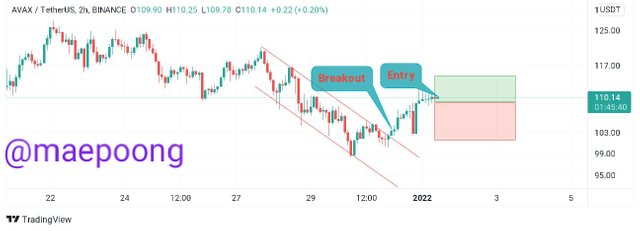
In this case I place a trade at the time of the breakout, I apply a 1:1 risk because if the market moves as I expected then I will get a profit of around $3 but if on the other hand I will lose about $3, this I think the risk is very small if my prediction was wrong. Then take profit and stop loss I place at $ 116 for take profit and $ 103 for stop loss.
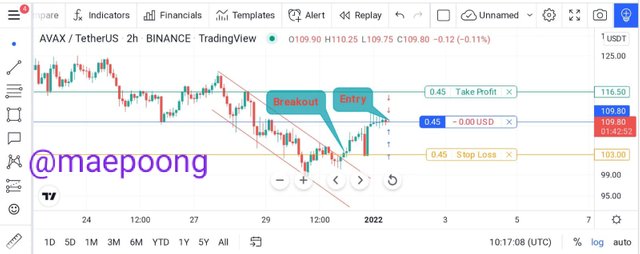
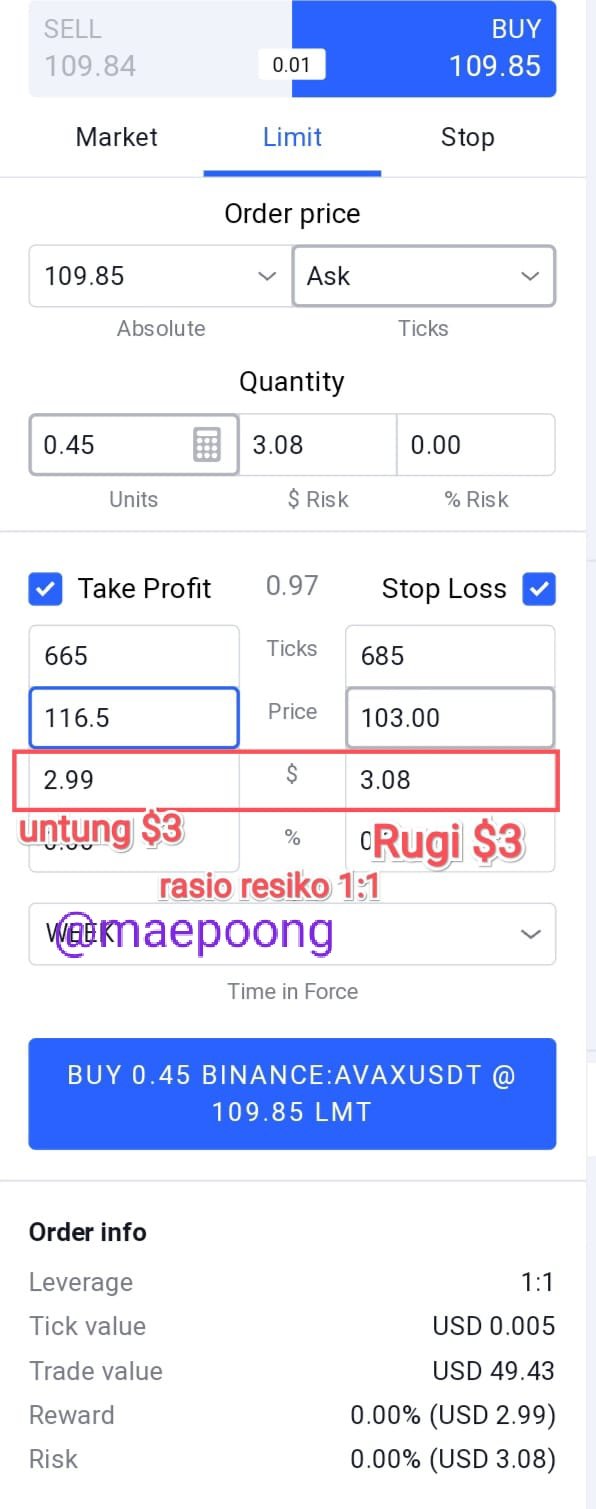
This is the result of my trade you can see all the details in the screenshot below.

b) Trend Continuation using Market Structure.
In the case of trend continuation I used the MATIC/USDT token, when I entered the market the trend was Bullish and it shows that the highs and lows are higher as seen in the chart below, when the trend is up the trend lines touch several times to show the value.
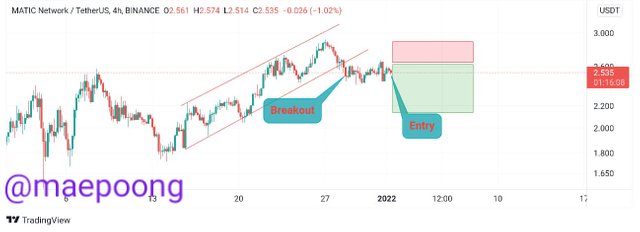
After I found the entry point now I enter the trade by applying risk and in this case I use a 1:1 ratio of course with the aim of minimizing losses if my prediction is wrong.
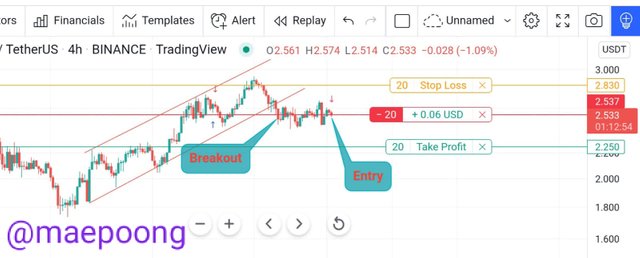
My Take-Profit is at 2250 Matic while Stop-loss is 2.830 Matic as shown in the screenshot above.20 Matic is equivalent to $50.6
But because I was a little late, so I immediately used the current price to enter the market. And the results I got were as shown in the screenshot below.


Conclusion

Before opening trading positions or allocating funds to an investment portfolio, traders and investors should consider developing a risk management strategy. However, it is important to remember that financial risk cannot be completely avoided.
Overall, risk management defines how to deal with risk, not just how to mitigate it. There must also be strategic thinking to reduce unavoidable risks in the most effective way.
In other words, risk management should include risk identification, risk assessment, and risk monitoring. The risk management process is designed to assess the risk/return ratio so that investors can find the most profitable trading positions.
Finally, thank you very much Professor @reminiscence01 for his extraordinary lecture, hopefully it will be useful for all of us.
all pictures are taken from tradingview.com